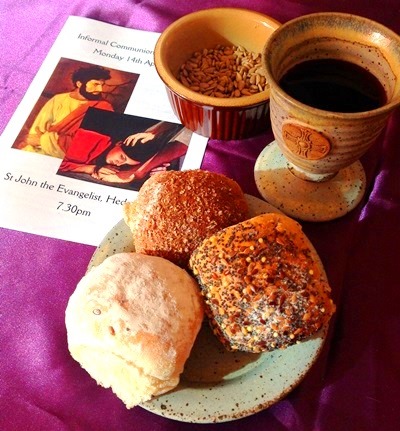Alleluia! Christ is risen
He is risen indeed. Alleluia!
It was with this greeting and response; as we sat down to share our evening meal that a new term began at college. It was only two days beforehand that I had sat next to the Easter cross in my home church, celebrating Easter Sunday and here I was, back to my studies but with new tasks to complete and new challenges. It seemed the same, but then again it also seemed different
I suspect it was the like that for the women, who approached the tomb on the first day of the week. Yes, a dreadful thing had happened and yes, they were probably a bit disorientated and shaken, but they were coming to do what they would always have done if someone died – that at least was normal, but what happened next was very different
Each Gospel gives a slightly different version of accounts. In Mark there are several women together to who arrive to anoint the body, only to find that the stone sealing the tomb had been rolled back and inside was a young white-robed man telling them not to be afraid, but that the body wasn’t there. Despite his call for calm, they are terrified and flee from the tomb, too afraid to tell anyone what they have seen
In Matthew, it is two Marys who go to look at the tomb, only to experience an earthquake, caused by an angel’s descent from heaven; who puts the guards into a stupor and then shows them that Jesus is not in the tomb. He sends them fearfully, yet joyfully, to deliver a message to the disciples that they are to return to Galilee, only for them to meet Jesus himself who confirms what they must do.
In Luke we again hear about a group of women, who meet two dazzlingly dressed men and after being reminded of what Jesus had previously told them, return to the disciples only to be accused of idle talk until Peter runs to look for himself.
Finally, in John, it is Mary Magdalene who, on seeing that the stone has been removed, runs back to tell this to Simon Peter and the beloved disciple, who both then set off towards the tomb, the latter outrunning Peter to reach the tomb, but respectfully waiting for Peter to enter it first, only to be met by discarded linen wrappings. However, it is after this that Mary in a bitter-sweet moment encounters Jesus and can report this back to all the disciples.
All of these accounts add to the story of what happened, but the one fact that they all substantiate is that the tomb was empty.
‘Do not be afraid; I know that you are looking for Jesus who was crucified.
He is not here; for he has been raised, as he said.’ Matthew 28:5-6
I often wonder if it shouldn’t be the tomb that is used more as an image of Christ’s resurrection, a permanent reminder of the defeat of death – but equally it is the empty cross that is a powerful and iconic symbol of transformation to which we are drawn.
The truth is that in a way this transformation is what was happening on Sunday, as I watched people, coming forward to place a flower around the cross. The blooms themselves were fresh and vibrant, and everyone placed them as carefully as they could, trying not to bruise the petals. However, some found it difficult to push them into the ‘ground’, while others knew exactly the spot they wanted in relation to the position of the cross. One flower in particular caught my attention – a beautiful cream tulip, streaked with red, that was placed right in the centre at the very foot – which looked this morning as if its cup had opened up to catch the blood that would have fallen from Jesus’ body
Yet, as beautiful as this display had become, each single representative bloom was already dying; just as we are called to die to Christ in order to be transformed and given new life. This truly is the joy of the Easter message and yet not everyone chooses to respond to it. That, no doubt, is the greatest regret as far as God is concerned as he tries, in love, to reconcile all of his creation. However, it still doesn’t mean that we shouldn’t try and do our part by sharing the Good News
Alleluia! Christ is risen
He is risen indeed. Alleluia!









